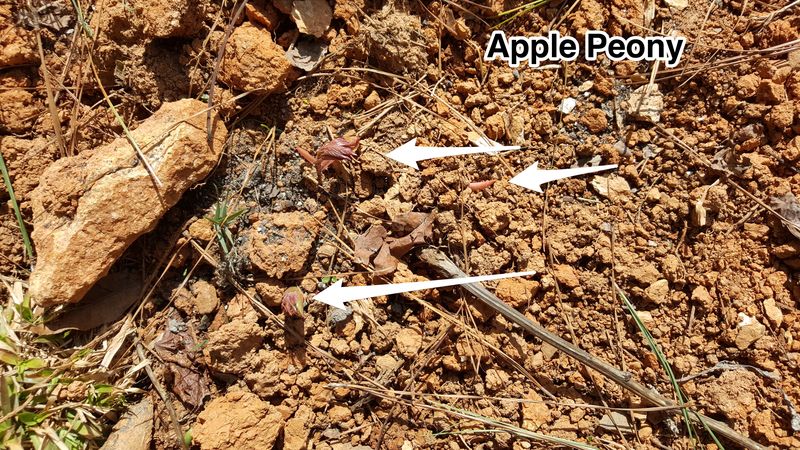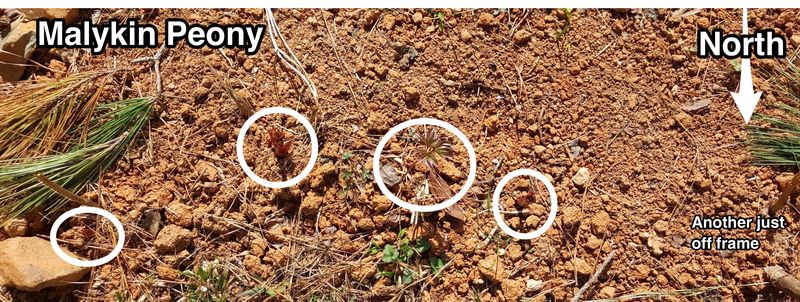Paeoniaceae: Paeonia sp. (Peony)
20180305 Successful division of Malykin peony and the Apple peony has survived


20180127 ... was very mild, and so i also got out and planted the daffodil bulbs i'd dug up in Dec, crocus bulbs and onions i'd bought on a whim, the Paeoniaceae: Paeonia sp. (Peony) i'd dug up, and the Paeoniaceae: Paeonia sp. (Peony) from Christine's Aunt Rachel i was certain had died in the long freeze, sitting in a planter. The peony i dug up i failed to have patience to properly divide. We'll see if the smaller root bits manage to cope. ... the slow melt of the snow meant the clay was just the right moisture to be easy but not a mess.
20171206 dug up Malykin Paeoniaceae: Paeonia sp. (Peony)
20170402 potted Grandmother Apple’s homeplace peony in large resin turquoise pot
20170321 Received peony from Diana, from Anita, from Aunt Rachel
This makes them even more special: Dawn says "The peonies originally came from your Grandmother Apple's homeplace."
20170319 more sprouts - also managed just fine through a freezing night when i forgot to cover it.
20170314 two more sprouts. The larger ones were pushing up on the cover.
20170310 sprouted (2). Covering during frozen nights.
consider spring purchase http://www.terraceiafarms.com/page/peony-clump
See very detailed http://peonysenvy.com/peonycare.html#type
- Dig holes 1’ deep, 1’ diameter
- Dig additional depth and add gravel for drainage
- Amend with some lime, rotted wood chips
[Transplanting should be] completed in fall as the plants begin to go dormant, not in spring as they prepare to bloom. In September, [Plant peonies in the fall: in late September and October in most of the country, and even later in the South.- [2]] choose a spot in full sun (at least 6 hours per day), and prepare the soil with well-rotted manure and/or compost, working it in and loosening the soil down to 18 inches. [Soil should be neutral [2] - get some lime]
Dig the plants carefully to minimize root injury, and remove the foliage. If the plants are large, they'll probably do better if they're divided. Gently wash the soil off the large roots, then use a sharp, clean knife to divide the plant's crown. Make sure each division has 3-5 pink buds or healthy stems.
Dig a generous-sized hole, about two feet deep and two feet across in well-drained soil in a sunny spot. If the soil is heavy or very sandy, enrich it with compost. Incorporate about one cup of bonemeal into the soil. Tamp it firmly. [2]
placing the root just 2 inches below the soil surface. (In southern states, choose early-blooming varieties, plant them about an inch deep, and provide some shade.)
Plant divisions at least 3 feet apart (peonies need good air circulation) [ Plant away from trees or shrubs as peonies don’t like to compete for food and moisture. ... Set the root so the eyes face upward on top of the firmed soil - -[2]] in a hole so the soil level is no more than 2 inches above the buds on the root. If the peonies are planted too deeply, they may not bloom.
Water thoroughly.[2]
As it is, peonies resent disturbance and may not bloom for several years after transplanting -- especially if the plants are old. Water them well, checking for settling to make sure they are not too deep. If rain doesn't fall, water them every week or so until the ground freezes. Use a couple of inches of mulch in winter to prevent freezing and thawing from heaving the new plants out of the ground.
They’re hardy to Zone 3 and grow well as far south as Zones 7 and 8. In most of the country, the rules for success are simply full sun and well-drained soil. Peonies even relish cold winters, because they need chilling for bud formation.
Peonies make fine sentinels lining walkways and a lovely low hedge. After its stunning bloom, the peony’s bushy clump of handsome glossy green leaves lasts all summer, and then turns purplish or gold in the fall, as stately and dignified as any shrub.
In mixed borders, peonies bloom with columbines, baptisias, and veronicas, and combine well with irises and roses. Plant white peonies with yellow irises and a froth of forget-me-nots; set off pink peonies with blue Nepeta or violets.